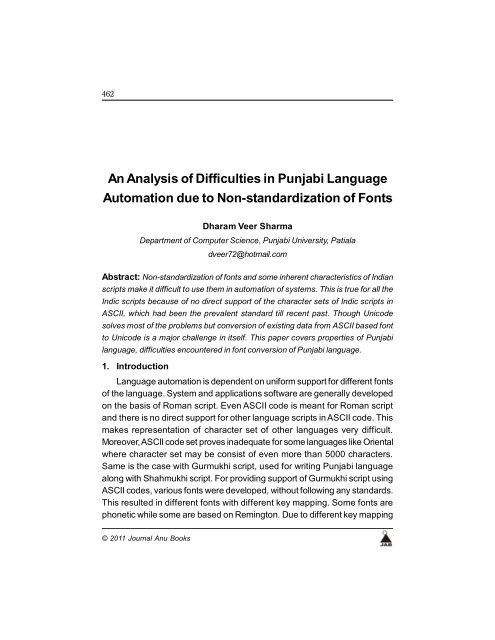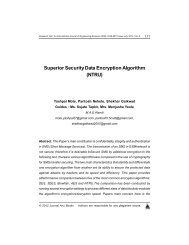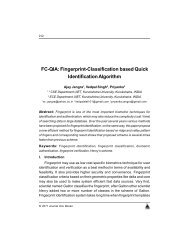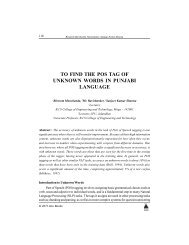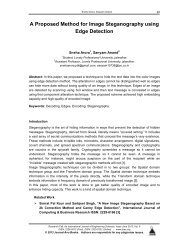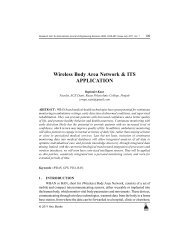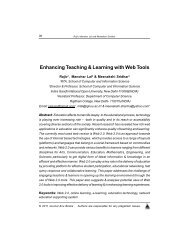An Analysis of Difficulties in Punjabi Language ... - Ijoes.org
An Analysis of Difficulties in Punjabi Language ... - Ijoes.org
An Analysis of Difficulties in Punjabi Language ... - Ijoes.org
You also want an ePaper? Increase the reach of your titles
YUMPU automatically turns print PDFs into web optimized ePapers that Google loves.
462<br />
<strong>An</strong> <strong>An</strong>alysis <strong>of</strong> <strong>Difficulties</strong> <strong>in</strong> <strong>Punjabi</strong> <strong>Language</strong><br />
Automation due to Non-standardization <strong>of</strong> Fonts<br />
Dharam Veer Sharma<br />
Department <strong>of</strong> Computer Science, <strong>Punjabi</strong> University, Patiala<br />
dveer72@hotmail.com<br />
Abstract: Non-standardization <strong>of</strong> fonts and some <strong>in</strong>herent characteristics <strong>of</strong> Indian<br />
scripts make it difficult to use them <strong>in</strong> automation <strong>of</strong> systems. This is true for all the<br />
Indic scripts because <strong>of</strong> no direct support <strong>of</strong> the character sets <strong>of</strong> Indic scripts <strong>in</strong><br />
ASCII, which had been the prevalent standard till recent past. Though Unicode<br />
solves most <strong>of</strong> the problems but conversion <strong>of</strong> exist<strong>in</strong>g data from ASCII based font<br />
to Unicode is a major challenge <strong>in</strong> itself. This paper covers properties <strong>of</strong> <strong>Punjabi</strong><br />
language, difficulties encountered <strong>in</strong> font conversion <strong>of</strong> <strong>Punjabi</strong> language.<br />
1. Introduction<br />
<strong>Language</strong> automation is dependent on uniform support for different fonts<br />
<strong>of</strong> the language. System and applications s<strong>of</strong>tware are generally developed<br />
on the basis <strong>of</strong> Roman script. Even ASCII code is meant for Roman script<br />
and there is no direct support for other language scripts <strong>in</strong> ASCII code. This<br />
makes representation <strong>of</strong> character set <strong>of</strong> other languages very difficult.<br />
Moreover, ASCII code set proves <strong>in</strong>adequate for some languages like Oriental<br />
where character set may be consist <strong>of</strong> even more than 5000 characters.<br />
Same is the case with Gurmukhi script, used for writ<strong>in</strong>g <strong>Punjabi</strong> language<br />
along with Shahmukhi script. For provid<strong>in</strong>g support <strong>of</strong> Gurmukhi script us<strong>in</strong>g<br />
ASCII codes, various fonts were developed, without follow<strong>in</strong>g any standards.<br />
This resulted <strong>in</strong> different fonts with different key mapp<strong>in</strong>g. Some fonts are<br />
phonetic while some are based on Rem<strong>in</strong>gton. Due to different key mapp<strong>in</strong>g<br />
© 2011 Journal <strong>An</strong>u Books
Research Cell: <strong>An</strong> International Journal <strong>of</strong> Eng<strong>in</strong>eer<strong>in</strong>g Sciences ISSN: 2229-6913 Issue Sept 2011, Vol. 4<br />
463<br />
it becomes difficult to convert from one font to another, whenever some<br />
data composed us<strong>in</strong>g one font is transferred to some other location for use<br />
(edit<strong>in</strong>g or pr<strong>in</strong>t<strong>in</strong>g), where the font used is not available, then there is a<br />
need either to send the font, used to edit the document, along with the<br />
document or to convert it to some font which is available on the target<br />
mach<strong>in</strong>e.<br />
Unicode was developed to overcome this problem and it has been<br />
successful <strong>in</strong> achiev<strong>in</strong>g the goal to some extent. But still Unicode has not<br />
been widely adopted for automation purposes and the huge amount <strong>of</strong> already<br />
exist<strong>in</strong>g data with different fonts add to the complexity <strong>of</strong> conversion to<br />
Unicode. This paper concentrates on difficulties problems <strong>of</strong> nonstandardization<br />
<strong>of</strong> fonts, problems encountered <strong>in</strong> font conversion and some<br />
rules for conversion from one font to another. The rest <strong>of</strong> the paper has<br />
been <strong>org</strong>anized as follows: section 2 covers overview <strong>of</strong> some <strong>of</strong> the Indian<br />
languages, section 3 covers a brief description and characteristics <strong>of</strong> <strong>Punjabi</strong><br />
language, section 4 covers the difficulties faced <strong>in</strong> font conversion and paper<br />
end with enlist<strong>in</strong>g the references used.<br />
2. A Brief Overview <strong>of</strong> Indian <strong>Language</strong>s<br />
There are 15 <strong>of</strong>ficially recognized Indian scripts [1]. These scripts are<br />
broadly divided <strong>in</strong>to two categories namely Brahmi scripts and Perso-Arabic<br />
scripts. The Brahmi scripts consist <strong>of</strong> Devanagari, Gurumukhi, Gujarati,<br />
Oriya, Bengali, Assamese, Telugu, Kannada, Malayalam, and Tamil. <strong>An</strong>d<br />
the Perso-Arabic scripts <strong>in</strong>clude Urdu, S<strong>in</strong>dhi and Kashmiri. Devanagari<br />
script is used by H<strong>in</strong>di, Marathi and Sanskrit languages. The characteristics<br />
<strong>of</strong> the languages with<strong>in</strong> the family are quite peculiar. They have the common<br />
phonetic structure, mak<strong>in</strong>g the common character set. With<strong>in</strong> the same<br />
family aga<strong>in</strong> north Indian scripts like, H<strong>in</strong>di, Marathi, Gurumukhi, Gujarati,<br />
Oriya, Bengali, Assamese have common features while Southern scripts<br />
like Tamil, Telugu, Kannada and Malayalam have common features.<br />
All these scripts mentioned above are written <strong>in</strong> a nonl<strong>in</strong>ear fashion.<br />
Unlike English, the width <strong>of</strong> the characters is different even on a same script.<br />
The division between consonant and vowel is applied for all Indian scripts.<br />
The vowels gett<strong>in</strong>g attached to the consonant are not <strong>in</strong> one (or horizontal)<br />
© 2011 Journal <strong>An</strong>u Books
464<br />
Dharam Veer Sharma<br />
directions; they can be placed either on the top or the bottom <strong>of</strong> consonant.<br />
This makes the use <strong>of</strong> the scripts on computers more complicated to<br />
represent them.<br />
3. Brief Description and characteristics <strong>of</strong> <strong>Punjabi</strong> <strong>Language</strong>:<br />
<strong>Punjabi</strong> is classified as a member <strong>of</strong> the Indo-Aryan subgroup <strong>of</strong> the<br />
Indo-European family <strong>of</strong> languages. The <strong>Punjabi</strong> language is a descendent<br />
<strong>of</strong> the Sauraseni Prakrit, a language <strong>of</strong> medieval northern India. It is believed<br />
to have developed as a dist<strong>in</strong>ct language from the Shauraseni Apabhramsha<br />
language around the 11th century. Other early <strong>in</strong>fluences on <strong>Punjabi</strong> <strong>in</strong>clude<br />
Indo-Aryan and pre-Indo-Aryan languages.<br />
India is a country <strong>of</strong> 122 languages; among these 22 are <strong>of</strong>ficial languages<br />
declared by Government <strong>of</strong> India. <strong>Punjabi</strong> language is world’s 12 th most<br />
widely spoken language [2]. <strong>Punjabi</strong> <strong>Language</strong> is used <strong>in</strong> both parts <strong>of</strong><br />
Punjab, <strong>in</strong> India and also <strong>in</strong> Pakistan. <strong>Punjabi</strong> is syllabic <strong>in</strong> nature. It consists<br />
<strong>of</strong> 41 consonants called vianjans, 9 vowel symbols called laga or matras<br />
and 2 symbols for nasal sounds ( . , ° ) .Modern <strong>Punjabi</strong> is a very tonal<br />
language, mak<strong>in</strong>g use <strong>of</strong> various tones to differentiate words that would<br />
otherwise be identical. Three primary tones can be identified: high-ris<strong>in</strong>gfall<strong>in</strong>g,<br />
mid-ris<strong>in</strong>g-fall<strong>in</strong>g, and low-ris<strong>in</strong>g. Follow<strong>in</strong>g are characteristics <strong>of</strong><br />
<strong>Punjabi</strong> language [3] [4].<br />
3.1 Morphological Characteristics<br />
Morphologically, <strong>Punjabi</strong> is an agglut<strong>in</strong>ative language. That is to say,<br />
grammatical <strong>in</strong>formation is encoded by way <strong>of</strong> affixation (largely suffixation),<br />
rather than via <strong>in</strong>dependent freestand<strong>in</strong>g morphemes. <strong>Punjabi</strong> nouns <strong>in</strong>flect<br />
for number (s<strong>in</strong>gular, plural), gender (mascul<strong>in</strong>e, fem<strong>in</strong><strong>in</strong>e), and declension<br />
class (absolute, oblique). The absolute form <strong>of</strong> a noun is its default or<br />
un<strong>in</strong>flected form. This form is used as the object <strong>of</strong> the verb, typically when<br />
<strong>in</strong>animate, as well as <strong>in</strong> measure or temporal (po<strong>in</strong>t <strong>of</strong> time) constructions.<br />
There are seven oblique forms <strong>in</strong> <strong>Punjabi</strong>, correspond<strong>in</strong>g more or less to<br />
the case forms: agentive/nom<strong>in</strong>ative, accusative-dative, <strong>in</strong>strumental,<br />
ablative, genitive, locative, and vocative. All cases except for the vocative<br />
are dist<strong>in</strong>guished by means <strong>of</strong> postpositions. The vocative form takes no<br />
© 2011 Journal <strong>An</strong>u Books
Research Cell: <strong>An</strong> International Journal <strong>of</strong> Eng<strong>in</strong>eer<strong>in</strong>g Sciences ISSN: 2229-6913 Issue Sept 2011, Vol. 4<br />
465<br />
postposition, but may be preceded by a vocative particle or term <strong>of</strong> address.<br />
<strong>Punjabi</strong> verbs <strong>in</strong>flect for tense, aspect (perfective, imperfective), mood<br />
(<strong>in</strong>dicative, imperative, and subjunctive, conditional), voice (active, passive),<br />
person, number, and gender. In this way, <strong>Punjabi</strong> verbs agree with their<br />
subjects, as is the case with other Indic languages. Adjectives <strong>in</strong>flect for<br />
gender and number and thus agree with the nouns they modify. Adverbs do<br />
not <strong>in</strong>flect. With respect to morphology, <strong>Punjabi</strong> and Gujarati are nearly<br />
identical.<br />
3.2 Syntactic Characteristics<br />
General syntactic structure <strong>of</strong> <strong>Punjabi</strong> language is Subject, Object and<br />
Verb (SOV). <strong>Punjabi</strong> sentences are ma<strong>in</strong>ly simple <strong>in</strong> structure but complex<br />
and compound sentences are also found <strong>in</strong> literature. <strong>Punjabi</strong> sentence<br />
structure is flexible. Depend<strong>in</strong>g on the context or mood <strong>of</strong> the speaker, it<br />
might vary. <strong>Punjabi</strong> sentences are mostly analytic <strong>in</strong> structure but the feature<br />
<strong>of</strong> synthesis is still found at dialectal level.<br />
3.3 Technical Characteristics<br />
Each <strong>Language</strong> has its own script suited to its particular needs and<br />
there are certa<strong>in</strong> rules govern<strong>in</strong>g its writ<strong>in</strong>g and usage. These rules perta<strong>in</strong><br />
to its script, vowel-signs, correct pronunciation, numerals, spell<strong>in</strong>gs and its<br />
dialectical variations, punctuation marks, phonemes and their nearest<br />
equivalents <strong>in</strong> other languages, standard term<strong>in</strong>ology, forms <strong>of</strong> verbs,<br />
declensions and other grammatical subtleties.<br />
3.4 Punctuation Marks<br />
Punctuation marks are symbols that <strong>in</strong>dicate the structure and<br />
<strong>org</strong>anization <strong>of</strong> written language, as well as <strong>in</strong>tonation and pauses to be<br />
observed when read<strong>in</strong>g aloud. By analyz<strong>in</strong>g a syntactic construction and<br />
word formation, punctuation marks delimit<strong>in</strong>g them to the concerned fractions<br />
explicate the underly<strong>in</strong>g mean<strong>in</strong>g perfectly. In the ancient <strong>Punjabi</strong> s<strong>in</strong>gle full<br />
stop bar (.) or double full stop bar (..) had been <strong>in</strong> vogue only. However, to<br />
the present day <strong>Punjabi</strong> besides Dandi (.) many other marks are used out<br />
<strong>of</strong> which the mark <strong>of</strong> Dandi (.) has been reta<strong>in</strong>ed from old <strong>Punjabi</strong> while all<br />
other marks have been derived from English.<br />
© 2011 Journal <strong>An</strong>u Books
466<br />
Dharam Veer Sharma<br />
4. <strong>Difficulties</strong> faced <strong>in</strong> font conversion<br />
Due to non-standardization <strong>of</strong> keyboard layouts, font conversion is not an<br />
easy task to achieve. There are some other additional problems which make<br />
the task, <strong>of</strong> conversion from one font to another, difficult. These problems<br />
are discussed below:<br />
4.1 Different keyboard layouts: There is no standardization <strong>of</strong> <strong>Punjabi</strong><br />
keyboard layouts. There are more than forty keyboard layouts and more<br />
than 500 fonts commonly be<strong>in</strong>g used, which means that the same <strong>Punjabi</strong><br />
word can be <strong>in</strong>ternally stored <strong>in</strong> forty different ways. As for example, the<br />
word gzi kphis <strong>in</strong>ternally stored <strong>in</strong> follow<strong>in</strong>g fonts by us<strong>in</strong>g different key map<br />
[5] [6].<br />
Table 1: Key map <strong>of</strong> word gzi kph>,@ <strong>in</strong> different fonts<br />
Font Name<br />
Akhar<br />
Amrit-Lipi2<br />
<strong>An</strong>andpur<br />
Sahib Asees<br />
Satluj<br />
Sukhmani<br />
Key Map<br />
pMjwbI<br />
pMj`bI<br />
pµj;bI<br />
Gzikph<br />
ê³ÜÅìÆ<br />
P^JABI<br />
The thesaurus has to deal with each <strong>of</strong> these cases separately and<br />
read the whole word. Even <strong>in</strong> the same font, a character can be typed and<br />
stored <strong>in</strong> more than one ways.<br />
4.2 <strong>Punjabi</strong> language has phonetic nature: One <strong>of</strong> the unique features <strong>of</strong><br />
<strong>Punjabi</strong>, <strong>in</strong> the variety <strong>of</strong> modern South Asian <strong>Language</strong>s, is the presence <strong>of</strong><br />
pitch contours. These change the mean<strong>in</strong>g <strong>of</strong> the word depend<strong>in</strong>g on the<br />
way it sounds. In technical terms these are called ‘tones’ and these are <strong>of</strong><br />
three types: low, high and level.<br />
© 2011 Journal <strong>An</strong>u Books
Research Cell: <strong>An</strong> International Journal <strong>of</strong> Eng<strong>in</strong>eer<strong>in</strong>g Sciences ISSN: 2229-6913 Issue Sept 2011, Vol. 4<br />
467<br />
Table 2: Example <strong>of</strong> one word hav<strong>in</strong>g different tones<br />
4.3 Complexity <strong>in</strong> typ<strong>in</strong>g: <strong>Punjabi</strong> typ<strong>in</strong>g is much more complex as<br />
compared to English typ<strong>in</strong>g, as 57 characters have to be typed on the<br />
standard QWERTY keyboard. One has to memorize the <strong>Punjabi</strong> characters<br />
correspond<strong>in</strong>g to the English keys and search out each character and then<br />
worry whether to type it with SHIFT or without SHIFT.<br />
4.4 Absence <strong>of</strong> well def<strong>in</strong>ed word boundaries: Unlike English, there is<br />
no well def<strong>in</strong>ed word boundary for <strong>Punjabi</strong> words written <strong>in</strong> different <strong>Punjabi</strong><br />
fonts. As for example, <strong>in</strong> Asees font the follow<strong>in</strong>g punctuation marks are<br />
encoded as <strong>Punjabi</strong> characters and thus are part <strong>of</strong> the word (‘ “ + / : ; [ ]<br />
\ { } ). But there are many other fonts such as Akhar, Satluj etc. which do not<br />
encode the above punctuation marks as <strong>Punjabi</strong> characters. So the<br />
extraction <strong>of</strong> word boundary is font dependent <strong>in</strong> case <strong>of</strong> <strong>Punjabi</strong>. In English<br />
and <strong>in</strong> many other languages, special characters and delimiters separate<br />
one word from another word. But <strong>in</strong> various different fonts <strong>of</strong> <strong>Punjabi</strong>, with<br />
the help <strong>of</strong> these special characters and delimiters some letters to be put <strong>in</strong><br />
word. This is clear from the follow<strong>in</strong>g table:<br />
Table 3: Keymap <strong>of</strong> words consist <strong>of</strong> delimiters and special characters <strong>in</strong> different<br />
fonts<br />
© 2011 Journal <strong>An</strong>u Books
468<br />
Dharam Veer Sharma<br />
4.5 Non-l<strong>in</strong>ear writ<strong>in</strong>g style: <strong>Punjabi</strong> is not written <strong>in</strong> l<strong>in</strong>ear fashion. The<br />
structure <strong>of</strong> the Gurmukhi script, the script for <strong>Punjabi</strong>, is non-l<strong>in</strong>ear i.e.<br />
besides 41 consonants <strong>of</strong> the language; there are other symbols such as<br />
Laga, Lagakhar etc, which are used to represent the phonetic structure <strong>of</strong><br />
the word. These symbols <strong>in</strong>herently decorate the consonant. For example,<br />
the word ‘COMPUTE’ as written <strong>in</strong> English, the character ‘O’ is called the<br />
colleague <strong>of</strong> ‘C’, ‘M’ is called the colleague <strong>of</strong> ‘O’ and so on, but <strong>in</strong> <strong>Punjabi</strong> it<br />
will be written as ‘ezfgT{N’ where character e is said to be wear<strong>in</strong>g a cap, g is<br />
hold<strong>in</strong>g a stick and T is wear<strong>in</strong>g shoes.<br />
4.6 Lack <strong>of</strong> spell<strong>in</strong>g standardization: There is no standardization <strong>of</strong> <strong>Punjabi</strong><br />
spell<strong>in</strong>gs. A word may be spelled <strong>in</strong> more than one way and all the forms<br />
may be acceptable. This problem ma<strong>in</strong>ly exists because <strong>of</strong> presence <strong>of</strong> too<br />
many dialects <strong>in</strong> Punjab. <strong>Punjabi</strong> language has many different dialects,<br />
spoken <strong>in</strong> different sub-regions <strong>of</strong> greater Punjab. Different dialects <strong>of</strong> <strong>Punjabi</strong><br />
are Majhi, Malwi, Doabi, Pothohari, jhangvi, Multani etc. Residents <strong>of</strong> one<br />
dialect pronounce one word <strong>in</strong> different manner from residents <strong>of</strong> another<br />
dialect. The problem arises when they write the words as they actually<br />
pronounce it. Follow<strong>in</strong>g are some words which are pronounced <strong>in</strong> different<br />
manner only with one sound change but written <strong>in</strong> different manner depend<strong>in</strong>g<br />
upon pronunciation. These words are sometimes called homonyms.<br />
- n kgDk, n kgBk<br />
- fpgohs , ft gohs<br />
- r {Vk, r {VQk<br />
- j B/ok, j BQ/ok<br />
- n B'yk, n B"yk<br />
4.7 Zero width <strong>of</strong> some characters: In some <strong>of</strong> the <strong>Punjabi</strong> fonts, the <strong>Punjabi</strong><br />
characters such as b<strong>in</strong>di, lava, onkar, dula<strong>in</strong>kar etc. have zero width and so<br />
if by mistake a user makes multiple entries <strong>of</strong> such characters only a s<strong>in</strong>gle<br />
© 2011 Journal <strong>An</strong>u Books
Research Cell: <strong>An</strong> International Journal <strong>of</strong> Eng<strong>in</strong>eer<strong>in</strong>g Sciences ISSN: 2229-6913 Issue Sept 2011, Vol. 4<br />
469<br />
entry is visible. Follow<strong>in</strong>g table shows some words written by s<strong>in</strong>gle entry <strong>in</strong><br />
some fonts but some font require more than one entry to spell same word.<br />
Table 4: Same words make use <strong>of</strong> different key entry <strong>in</strong> different fonts<br />
References<br />
[1] Meenu Bhagat, “Spell<strong>in</strong>g Error Pattern <strong>An</strong>alysis <strong>of</strong> <strong>Punjabi</strong> Typed Text”,<br />
M. Tech. thesis Report, Thapar University, Patiala.<br />
[2] Nirma Garg, “Font Independent Spell Checker for <strong>Punjabi</strong> Us<strong>in</strong>g<br />
Gurumukhi Script”, M. Tech. thesis report, Department <strong>of</strong> Computer<br />
Science, <strong>Punjabi</strong> University, Patiala, 2010.<br />
[3] Rup<strong>in</strong>derdeep Kaur, R.K.Sharma, Suman Preet and Parteek Bhatia,<br />
“<strong>Punjabi</strong> WordNet Relations and Categorization <strong>of</strong> Synsets”, M. Tech.<br />
thesis report, Thapar University, Patiala<br />
[4] Dharam Veer Sharma and Aarti, “<strong>Punjabi</strong> <strong>Language</strong> Characteristics<br />
and Role <strong>of</strong> Thesaurus <strong>in</strong> Natural <strong>Language</strong> Process<strong>in</strong>g”, International<br />
Journal <strong>of</strong> Computer Science and Information Technologies, vol. 2,<br />
pp. 1434-1437, 2011.<br />
[5] G S Lehal, “Design and Implementation <strong>of</strong> <strong>Punjabi</strong> Spell Checker”,<br />
International Journal <strong>of</strong> Systemics, Cybernetics and Informatics, pp.<br />
70-75, Jan 2007.<br />
[6] accessed on 15 May, 2011.<br />
© 2011 Journal <strong>An</strong>u Books


